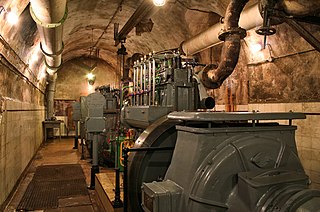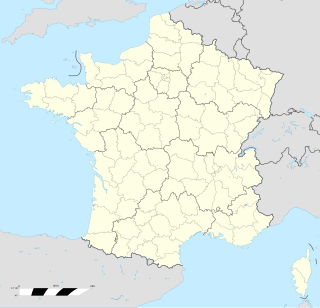
The Aiguille du Dru is a mountain in the Mont Blanc massif in the French Alps. It is situated to the east of the village of Les Praz in the Chamonix valley. "Aiguille" means "needle" in French.

Ouvrage Kobenbusch is a gros ouvrage of the Maginot Line, located in the Fortified Sector of Thionville in the Cattenom forest. It possesses seven combat blocks and two entrance blocks, one for ammunition and the other for men. It is located between petit ouvrage Bois-Karre and petit ouvrage Oberheid, and was named for the surrounding Kobenbusch forest. The position saw little action during World War II. Its deep passages have been flooded by the construction of a cooling water lake for a nearby nuclear power plant, but its surface features are being developed with an interpretive path through the surrounding forest.

Ouvrage Hochwald is a gros ouvrage of the Maginot Line, one of the largest fortifications in the Line. Located on the Hochwald ridge in the Fortified Sector of Haguenau in the community of Drachenbronn-Birlenbach in the Bas-Rhin department of northeastern France, it was designed to protect the northern Vosges region of France. Ouvrage Hochwald is sometimes considered as two ouvrages because of its separation of the western and the eastern portions of the ouvrage. Uniquely, the original plans for the position included an elevated battery to the rear with long-range 145 mm or 155 mm gun turrets of a new kind. Hochwald is used by the French Air Force as an armoured air defense coordination center.

Ouvrage Michelsberg, one of the Maginot Line fortifications, formed part of the Fortified Sector of Boulay as well as the fortified region of Metz. The ouvrage is located in Moselle (département) between the towns of Dalstein and d'Ebersviller, about 23 km from Thionville. It is located between gros ouvrage Mont des Welches and petit ouvrage Hobling, facing Germany. Michelsberg did not see significant action in the Battle of France until June 1940, when it was attacked from the rear by German forces that had bypassed the Maginot Line. It successfully resisted these attacks, but was compelled to surrender in accordance with the 25 June 1940 armistice. After the Second World War it was renovated as a Cold War fortification against a potential Soviet invasion, then abandoned. It is now operated as a museum, and may be visited.

Ouvrage Bovenberg is a lesser work of the Maginot Line. Located in the Fortified Sector of Boulay, the ouvrage is located between petits ouvrages Berenbach and Denting, facing Germany. It consists of two infantry blocks and two artillery blocks.

Ouvrage Coume Annexe Sud is a lesser work of the Maginot Line. Located in the Fortified Sector of Boulay, the ouvrage consists of two infantry blocks, one artillery block and one observation block, and is located between petits ouvrages Coume and Mottemberg, facing Germany.

Ouvrage Téting is a lesser work of the Maginot Line. Located in the Fortified Sector of Faulquemont, the ouvrage consists of one infantry block and two observation blocks, and is located facing Germany between petits ouvrages Laudrefang and the Saar valley, which was to be inundated in times of emergency. With artillery support from its neighbor Laudrefang, Téting held out against German bombardment during the Battle of France in 1940. It is now abandoned.

Ouvrage Molvange is a large work, or gros ouvrage of the Maginot Line. The fortification complex faces the France-Luxembourg border from a height near Entrange in the Moselle département. The complex, armed and occupied in 1935, is located on the heights of Entrange, at an altitude of about 400 meters (1,300 ft). Molvange is flanked by the even larger Ouvrage Rochonvillers to the west and smaller petit ouvrage Immerhof to the east, part of the Fortified Sector of Thionville. Molvange was not involved in significant combat during World War II, but due to its size it was repaired and retained in service after the war. During the Cold War Molvange's underground barracks and former ammunition magazine became a hardened military command center.

Ouvrage Mauvais-Bois is a petit ouvrage of the Fortified Sector of the Crusnes on the Maginot Line. It is located between the gros ouvrage Latiremont and the petit ouvrage Bois-du-Four, facing the Belgium/Luxembourg border. The original plan for the position was for two phases of construction, resulting in a gros ouvrage provided with heavy artillery. The increase in tension between France and Germany in the late 1930s caused resources to be diverted elsewhere, and only the first three combat blocks were built. In 1940 the ouvrage was regularly bombarded, but not directly attacked by German infantry. When the French military divested itself of the majority of the Maginot fortifications, Mauvais-Bois was the second to be sold.

Ouvrage Bois-du-Four is a lesser work in the Fortified Sector of the Crusnes of the Maginot Line. The ouvrage consists of a single large combat block without an underground gallery system, and is located between petit ouvrage Mauvais-Bois and gros ouvrage Bréhain, facing Luxembourg. A planned expansion, never carried out, was intended to enlarge Bois-du-Four into a fully equipped gros ouvrage. Bois-du-Four saw little action in either the Battle of France in 1940 or the Lorraine Campaign of 1944. It is preserved by the community of Villers-la-Montagne and may be visited.

Ouvrage Bréhain is part of the Fortified Sector of the Crusnes of the Maginot Line, located near the community of Bréhain-la-Ville in the Meurthe-et-Moselle département of France. Bréhain is flanked by petits ouvrages Mauvais Bois and Aumetz. The gros ouvrage was equipped with long-range artillery, and faced the border with Luxembourg. It saw no major action in either the Battle of France in 1940 or the Lorraine Campaign of 1944. While not open to public visitation, it has been secured and is in relatively good condition when compared to other abandoned Maginot positions. A flanking casemate has been restored and may be visited.

Ouvrage Aumetz is a small work, or petit ouvrage of the Maginot Line. It is part of the Fortified Sector of the Crusnes and is located near the community of Aumetz in the Moselle département of France. The petit ouvrage flanked by the gros ouvrages Bréhain and Rochonvillers, all facing the France-Luxembourg border. Aumetz was initially planned as a gros ouvrage of six combat blocks, but only three infantry blocks were built. Aumetz saw limited action during the Battle of France. In the 1970s it was the first Maginot position to be offered for sale to the public.

Ouvrage Immerhof, also known as Ouvrage Ferme-Immerhof, is one of the largest petit ouvrages of the Maginot Line of northeast France. Located near the community of Hettange-Grande, it is 7 km north of Thionville between the gros ouvrages of Molvange and Soetrich, the closest ouvrage to the Luxembourg frontier. It was part of the Fortified Sector of Thionville, in the Fortified Region of Metz, the strongest portion of the Line. Apart from its function as a communication post between the neighbouring gros ouvrages, Immerhof also controlled the road and railway routes from Luxembourg, which pass in the immediate vicinity. In addition, Immerhof protected other Maginot works in the vicinity: the casemates of Kanfen, the infantry shelter of Stressling, the observation point and shelter of Hettange-Grande, and a number of nearby blockhouses constructed during the Phoney War.

Ouvrage Haut-Poirier is a lesser work of the Maginot Line. The ouvrage consists of one entry and three infantry blocks, and is located between the Saare valley and petit ouvrage Welschhof, facing Germany. It is the only ouvrage in the Fortified Sector of the Sarre, the remainder of the area being covered by smaller blockhouses and areas of inundation. It was assaulted by German forces during the Battle of France and was captured after a seven-hour bombardment. Haut-Poirier is abandoned, although one of its satellite casemates is maintained as a museum.

Ouvrage Welschhof is a lesser work of the Maginot Line, located near Rohrbach-lès-Bitche in the Moselle department of northeastern France. Located in the Fortified Sector of Rohrbach, the ouvrage consists of three infantry blocks, and is located between petit ouvrage Haut-Poirier and gros ouvrage Simserhof, facing Germany. Welschhof was attacked by German forces during the Battle of France on 21 June 1940 and was forced to surrender after a heavy artillery bombardment. It was re-equipped after the war, but was abandoned in the 1970s.

Ouvrage Otterbiel forms part of the Maginot Line in the Fortified Sector of Rohrbach, Sub-sector of Bitche, and is located on the Camp de Bitche of the French Army. It is located between gros ouvrage Schiesseck and petit ouvrage Grand Hohekirkel. Part of the Fortified Sector of Rohrbach, the petit ouvrage comprises four combat blocks and an entry block. Due to budget restrictions, a planned flanking infantry block was never constructed. Otterbiel saw no significant action in the Battle of France, and limited action during the 1944/45 Lorraine Campaign. It was renovated for use during the Cold War. Otterbiel is used for ammunition storage by the French Army.

Ouvrage Rohrbach is a petit ouvrage of the Maginot Line located in the community of Bettvillier, near Rohrbach-lès-Bitche in the Moselle département, facing Germany. The Fortified Sector of Rohrbach was built somewhat later than its neighbors to the east and west, and in company with positions on the extreme western end of the Maginot Line, became one of the "New Fronts."

Ouvrage Simserhof is a gros ouvrage of the Maginot Line, located in the French commune of Siersthal in the Moselle department. It faces the German border and is adjoined by the petit ouvrage Rohrbach and the gros ouvrage Schiesseck. Located 4 km west of Bitche, the ouvrage derived its name from a nearby farm. It was part of the Fortified Sector of Rohrbach. During the Battle of France in 1940, the Simserhof supported its neighboring fortifications with partially successful covering artillery fire. After the surrender of France, it was repurposed by the Germans as a torpedoes storage depot, and later resisted the American advances of late 1944. The Americans briefly occupied the fort in the first days of 1945 until the German counter-offence of Operation Nordwind, which allowed them to take back control of the Simserhof. The fort was finally liberated by the 100th Infantry Division on March 15th 1945. Following the war, it was initially repaired for the French Army and later converted into a Maginot Line museum in the early 1960s. Retained by the Ministry of Defense, Simserhof now functions as a museum, and has the most extensive visitor infrastructure of any of the preserved Maginot fortifications.

Ouvrage Grand-Hohékirkel is a petit ouvrage of the Maginot Line, located near Bitche in the French département of Moselle. Grand-Hohékirkel is adjoined by gros ouvrage Otterbiel to the west and petit ouvrage Lembach at some distance to the east, and faces the German frontier. It was part of the Fortified Sector of the Vosges.

Ouvrage Chesnois, also known as Ouvrage Chênois, is a gros ouvrage of the Maginot Line, located in the Fortified Sector of Montmédy, facing Belgium. The ouvrage lies between the towns of Montlibert and Thonne-le-Thil. It possesses six combat blocks. It is located between gros ouvrage Thonnelle and petit ouvrvage La Ferté. The position was sabotaged and abandoned by French forces that were ordered to retreat from the exposed position in June 1940 during the Battle of France. The ouvrage is now abandoned and sealed.























